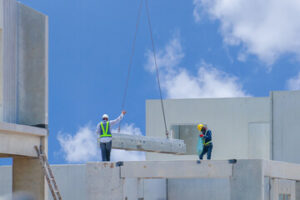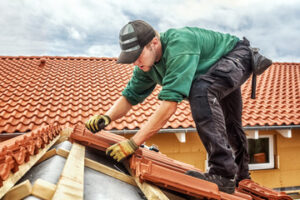Concrete is used to create driveways, sidewalks, patios, basements and other structures in homes across the country. But over time, it can sink or become uneven, creating tripping hazards and channeling water into basements and foundations.

Thankfully, there’s an easy and cost-effective solution to this problem- Concrete Lifting Bismarck. Also known as slabjacking or mudjacking, it’s done by drilling small holes and injecting a filler material under the concrete to raise it.
Concrete lifting elevates sunken concrete slabs back to their original level without replacement, a cost-effective and efficient solution that improves the appearance of driveways, patios, and other outdoor surfaces. It can save property owners up to 80% of the costs associated with complete replacement, including construction waste disposal, while also minimizing the environmental impact. In addition, it requires less materials than mudjacking and polyleveling, which are both concrete lifting methods that involve pumping cement mixtures beneath the surface.
Over time, buildings settle, house patios sink, and roadways shift, requiring costly replacement or repairs under the existing slab. This is often caused by soil erosion, improper compaction during initial construction, or freeze-thaw cycles. A concrete lifting contractor can restore these structures to their original condition by injecting high-density foam into holes drilled through the surface of the slab.
In contrast to traditional methods of restoring concrete, such as mudjacking and self-leveling compounds, concrete lifting with foam is faster, safer, and more durable, providing long-lasting results. These projects can usually be completed in just one day, minimizing disruption to daily routines and allowing the concrete to be used sooner. In addition, the minimal intrusion into the surrounding area from the small injection holes creates less damage to landscaping and other structures.
Mudjacking involves pumping a mixture of sand, clay, and cement beneath the surface of the concrete to lift it up, but this method has several drawbacks. The cement mixture adds excess weight to the existing slab, accelerating its further sinking, and the large holes required for injection can leave unsightly scars on the ground. Alternatively, the concrete lifting with foam technique uses a lighter material that does not add extra weight to the structure.
Concrete lifting with foam is also safer than other concrete leveling methods because it does not require any drilling or hammering of the existing structure. This process is typically performed by a qualified contractor and requires only minimal equipment, resulting in fewer safety risks than other methods. Additionally, the use of foam provides superior durability to the existing concrete, preventing future settlement and cracking.
Faster
Concrete is a popular building material that is often used in sidewalks, driveways, and patios. However, over time, soil erosion, changes in moisture, and inadequate compaction during construction can cause these concrete slabs to sink or become uneven. When this occurs, it is important to address the issue promptly to avoid further damage and costly repairs in the future. Edens Structural Solutions offers effective concrete lifting solutions that can help level sunken or uneven concrete surfaces. Compared to other methods, including Mudjacking, Concrete Lifting is more cost-effective and faster to complete.
Traditional repair methods involve tearing out existing concrete and pouring new. This is a time-consuming process that can take days to complete and the surface will be unusable during this time. In contrast, Poly Foam Concrete Lifting is a much quicker solution that involves injecting a lightweight foam underneath the existing slab to fill voids and raise the surface. This process can be completed in a matter of hours and the surface can be used immediately afterward.
Additionally, Poly Foam Concrete Lifting is less disruptive than mudjacking. Mudjacking requires pumping a cement-based slurry beneath the existing concrete which can lead to more extensive damage and a longer downtime. Poly Foam Concrete Lifting, on the other hand, uses a non-toxic and environmentally-friendly foam that is safe for surrounding vegetation and groundwater. This can help ensure that the repaired surface is safe for use by both pedestrians and vehicles.
The faster results of Poly Foam Concrete Lifting also make it a more efficient option when compared to traditional repairs. With a quicker turnaround, businesses can resume traffic in the area more quickly and minimize loss of revenue due to downtime. The fact that the cured foam can support weight within 15 minutes after injection is also a plus for those needing to quickly get their business back up and running.
While both methods can be effective in repairing concrete, it is important to choose the right method for your specific needs and property. Contact a concrete lifting specialist to learn more about the benefits of Poly Foam Concrete Lifting and compare it to other repair options.
Less Disruptive
Concrete Lifting is a less disruptive option than concrete replacement because it doesn’t require tearing up and replacing the existing slab. Instead, it involves pumping a specialized mixture beneath the concrete to raise and level it. This eliminates the need for demolition and reduces disruption to the surrounding area. Moreover, it doesn’t generate the significant environmental waste associated with slab replacement.
This approach also addresses underlying issues that contribute to sunken concrete, including soil instability and erosion. However, it isn’t ideal for addressing extensive damage to a concrete surface.
Another benefit of this method is that it requires less equipment than concrete replacement. Ripping out and installing a new concrete slab can involve large machinery that damages the grass and landscaping around it. Concrete lifting, on the other hand, requires only a small truck to perform the job. This minimizes the damage to your property and allows you to resume normal use much sooner than with other repair methods.
Although concrete lifting is a quick and cost-effective solution, the injection holes created can leave unsightly marks on the surface of the slab. If aesthetics are a concern, you may want to consider alternative methods like foam polyurethane injection. This approach is less disruptive and uses a durable material that blends in with the existing concrete. In addition, it is waterproof and can support heavy loads within a few hours, making it an excellent alternative to mud-jacking.
One of the most significant benefits of concrete lifting is its environmental impact. By reusing the existing concrete, it avoids the need for new materials and production, which significantly reduces energy consumption. In contrast, concrete replacement requires the removal and disposal of the old concrete as well as the production and installation of new concrete.
Choosing the right solution for your sunken concrete depends on the extent of the damage as well as the severity of the shifting. To ensure the durability of the lift, it is important to inspect the concrete regularly and take steps to prevent future settling. This includes ensuring proper drainage, directing water away from the concrete surface, and performing regular maintenance to prevent cracks. In addition, it is a good idea to seal the concrete to keep moisture out and reduce soil erosion underneath the slab.
Long-Lasting
Concrete is a popular building material for sidewalks, driveways, and patios. However, it can become damaged over time due to settling, weathering, and heavy loads. If the concrete isn’t repaired, it can develop cracks and uneven surfaces that are unsightly and can pose safety hazards.
Rather than replacing the entire slab, a cost-effective solution is concrete lifting. Concrete lifting uses a stone slurry grout to lift the concrete and fill any voids underneath. The process is faster and less disruptive than removing and replacing the slab, and it costs up to 80% less.
One advantage of concrete lifting over mudjacking or slurry grout is that it produces much more durable results. Mud jacking uses an unstable slurry to raise the concrete, which can cause it to sink again over time. Polyurethane foam lifting uses a stronger, more stable material that doesn’t require an unstable substrate to support it. It is also resistant to water and temperature erosion, extending the lifespan of the lifted surface.
The injected foam also creates minimal disruption to the surrounding area. It only requires a few holes to inject the material, minimizing the impact on nearby landscaping and structures. This method also allows for more precise lift amounts, which is important for areas that need to be resurfaced.
In addition, concrete lifting is a more environmentally friendly option than replacing the whole slab. Ripping out a concrete slab can involve large machinery that damages the grass and other landscaping around the worksite. This can lead to costly repairs and replacements down the road. Concrete lifting is more environmentally friendly because it preserves the existing concrete and reduces construction waste.
While concrete lifting can fix many issues, it isn’t a good solution for all types of damage. For instance, if the concrete was originally poured on improper soil or didn’t compact down properly, it cannot be lifted with this technique. Also, this process won’t help with problems caused by forces pushing down on the concrete (such as tree roots or expansive clay soil). If these issues are present, it’s best to replace the concrete instead of trying to repair it.



